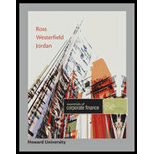
a)
To determine: The portfolios expected return
Introduction:
Expected return refers to the return that the investors expect on a risky investment in the future. Portfolio expected return refers to the return that the investors expect on a portfolio of investments.
a)
Answer to Problem 10QP
Explanation of Solution
Given information:
The probability of having a boom, good, poor, and bust economy are 0.15, 0.50, 0.25, and 0.10 respectively. Stock A’s return is 35 percent when the economy is booming, 12 percent when the economy is good, 1 percent when the economy is poor, and −11 percent when the economy is in a bust cycle.
Stock B’s return is 45 percent when the economy is booming, 10 percent when the economy is good, 2 percent when the economy is poor, and −25 percent when the economy is in a bust cycle.
Stock C’s return is 33 percent when the economy is booming, 17 percent when the economy is good, −5 percent when the economy is poor, and −9 percent when the economy is in a bust cycle. The weight of Stock A and Stock C is 30 percent each, and the weight of Stock B is 40 percent in the portfolio.
Formulae:
The formula to calculate the return on portfolio during a particular state of economy:
Where,
Rp refers to the return on portfolio
“x1 to xn” refers to the weight of each asset from 1 to “n” in the portfolio
R1 to Rn” refers to the rate of
The formula to calculate the portfolio expected return:
Where,
E(RP) refers to the expected return on a portfolio
“x1 to xn” refers to the probability of each asset from 1 to “n” in the portfolio
“E(R1) to E(Rn) ” refers to the expected return on each asset from 1 to “n” in the portfolio
Compute the return on portfolio during a boom:
Hence, the return on portfolio during a boom is 0.384 or 38.4%.
Compute the return on portfolio during a good economy:
Hence, the return on portfolio during a good economy is 0.127 or 12.7%.
Compute the return on portfolio during a poor economy:
Hence, the return on portfolio during a poor economy is −0.004 or −0.4%.
Compute the return on portfolio during a bust cycle:
Hence, the return on portfolio during a bust cycle is −0.16 or −16%.
Compute the expected return on portfolio:
Hence, the expected return on the portfolio is 0.1061 or 10.61%.
b)
To determine: The standard deviation and variance of the portfolio
Introduction:
Portfolio variance refers to the average difference of squared deviations of the actual data from the mean or expected returns.
Standard deviation refers to the variation in the actual returns from the expected returns of the assets. The square root of variance gives the standard deviation.
b)
Answer to Problem 10QP
The variance of the portfolio is 0.02346 and the standard deviation of the portfolio is 0.1532 or 15.32%.
Explanation of Solution
Given information:
The probability of having a boom, good, poor, and bust economy are 0.15, 0.50, 0.25, and 0.10 respectively. Stock A’s return is 35 percent when the economy is booming, 12 percent when the economy is good, 1 percent when the economy is poor, and −11 percent when the economy is in a bust cycle.
Stock B’s return is 45 percent when the economy is booming, 10 percent when the economy is good, 2 percent when the economy is poor, and −25 percent when the economy is in a bust cycle.
Stock C’s return is 33 percent when the economy is booming, 17 percent when the economy is good, −5 percent when the economy is poor, and −9 percent when the economy is in a bust cycle. The weight of Stock A and Stock C is 30 percent each, and the weight of Stock B is 40 percent in the portfolio.
Formulae:
The formula to calculate the variance of the portfolio:
The formula to calculate the standard deviation:
Compute the variance:
R1 refers to the returns of the portfolio during a boom. The probability of having a boom is P1. R2 is the returns of the portfolio in a good economy. The probability of having a good economy is P2. R3 is the returns of the portfolio in a poor economy. The probability of having a poor economy is P3. R4 is the returns of the portfolio in a bust cycle. The probability of having a bust cycle is P4.
Hence, the variance of the portfolio is 0.02346.
Compute the standard deviation:
Hence, the standard deviation of the portfolio is 0.1532 or 15.32%.
Want to see more full solutions like this?
Chapter 11 Solutions
ESSENTIALS OF CORP.FIN.-W/CODE >CUSTOM<
 Essentials Of InvestmentsFinanceISBN:9781260013924Author:Bodie, Zvi, Kane, Alex, MARCUS, Alan J.Publisher:Mcgraw-hill Education,
Essentials Of InvestmentsFinanceISBN:9781260013924Author:Bodie, Zvi, Kane, Alex, MARCUS, Alan J.Publisher:Mcgraw-hill Education,

 Foundations Of FinanceFinanceISBN:9780134897264Author:KEOWN, Arthur J., Martin, John D., PETTY, J. WilliamPublisher:Pearson,
Foundations Of FinanceFinanceISBN:9780134897264Author:KEOWN, Arthur J., Martin, John D., PETTY, J. WilliamPublisher:Pearson, Fundamentals of Financial Management (MindTap Cou...FinanceISBN:9781337395250Author:Eugene F. Brigham, Joel F. HoustonPublisher:Cengage Learning
Fundamentals of Financial Management (MindTap Cou...FinanceISBN:9781337395250Author:Eugene F. Brigham, Joel F. HoustonPublisher:Cengage Learning Corporate Finance (The Mcgraw-hill/Irwin Series i...FinanceISBN:9780077861759Author:Stephen A. Ross Franco Modigliani Professor of Financial Economics Professor, Randolph W Westerfield Robert R. Dockson Deans Chair in Bus. Admin., Jeffrey Jaffe, Bradford D Jordan ProfessorPublisher:McGraw-Hill Education
Corporate Finance (The Mcgraw-hill/Irwin Series i...FinanceISBN:9780077861759Author:Stephen A. Ross Franco Modigliani Professor of Financial Economics Professor, Randolph W Westerfield Robert R. Dockson Deans Chair in Bus. Admin., Jeffrey Jaffe, Bradford D Jordan ProfessorPublisher:McGraw-Hill Education





